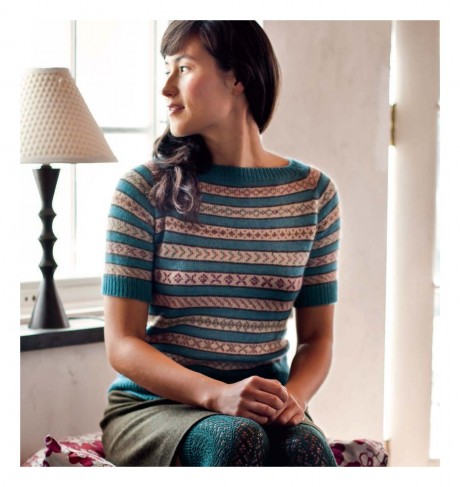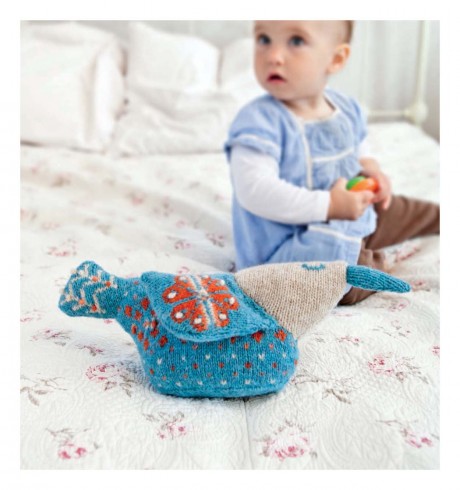Mary Jane Mucklestone is a knitting designer with a passion for intricate colourwork. Her two books (200 Fair Isle Designs and 150 Scandinavian Knitting Designs feature diverse ranges of motifs which could be adapted to suit many different colourwork projects. We caught up with her to chat about her newest release, Fair Isle Style (Interweave), a gorgeous collection of modern Fair Isle designs by 16 designers.
So how did you write Fair Isle Style? Talk us through the process.
I actually proposed this project years ago! Way back when I was the stylist for Interweave Knits, and Pam Allen was editor. In those days Fair Isle knitting was thought to be too specialized and not current so they passed on it. It’s just as well because in the years since, Fair Isle knitting and other stranded colourwork have gradually re-entered the fashion consciousness, and now you see it all over the runways and on the street. It has become really popular and looks like it’s here to stay.
The actual putting together of the book began by deciding what kind of projects I wanted to include and then putting out the call to a bunch of designers to see what they came up with. The actual time from when I got the official go-ahead to the due date for selecting the final pieces was incredibly short! I had no time to mull things over, but in a way it was great. I worked on instinct and I think we came up with a wonderful and varied group of projects. There’s something for everyone really - lots of great accessories, and some very significant sweaters too.

Fara Raglan by Courtney Kelly
There are lots of different designers in the book. How did you decide who to include?
I contacted friends who I knew loved colourwork, and others whose work I’d
always admired. I wanted to include designers who influenced me when I was
learning to knit like Nancy Bush and Norah Gaughan, and also newer designers I’d never met who impressed me with their fresh take on things, like Spilly Jane and Elinor Brown.
You’re well known for your intricate colourwork designs. Have you always been interested in the technique?
Yes I have. As a teenager I lived in London for a little while and I used to find jumpers in the thrift shops. I would marvel over them. I remember going into Patricia Roberts and just being awestruck by her things and all the yarn. I mustered up the courage to buy a pattern booklet even though I didn’t really know how to knit! Years later when I really started knitting in earnest I was always short of money - I never had enough to buy an entire sweaters worth of yarn, so fair isle work was ideal. I’d haunt the sale bin, and knit colourful sweaters for my kids!
How does traditional Fair Isle differ from other types of colourwork?
Fair Isle colourwork has a certain set of “rules” which if you follow make the work very simple and enjoyable: work in the round; never use more than two colours in any round; use symmetrical pattern motifs that are easy to memorise, the colours arranged in a reflecting order cut at the centre line.
How important were the Shetland islands in influencing you and the designers?
I can’t really speak for the other designers, but for me the islands were very influential. I’ve been lucky to visit several times with my friend Gudrun Johnston who was born there, and I’m struck by all the colours in the landscape. My Morrowless socks contain bright blue, bright green, ochre and orange, though a kind of vintage combination. You really do find those colours in nature: the brilliant blue sky, the ochre lichen, green grass and orangey reeds… and then those colours change to muted tones when the fog rolls in.
Do you have any Fair Isle tips for beginners who may be unsure about starting their first big project?
First of all relax and have fun. Try not to worry too much. Practice on a simple project first, Ysolda’s cowl or Kat Coyle’s skirt are two projects that have little or no shaping.
Which projects are you most proud of?
Oh my, this is a very hard question. I really have to say I’m very proud of them all, and I’m thrilled that such talented designers contributed to the book. If pressed, I must admit to having a very soft spot for Lucinda Guy’s Babsie Bird. She is the absolute cutest most darling bird toy ever!

Babsie Bird by Lucinda Guy
What was your biggest knitting disaster?
Well, it was a disaster until it wasn’t. I’d designed a pullover for a magazine and was assigned a superwash wool. I was assured that it would just be fine with steeking. As usual I was working against an impossible deadline, so I reinforced and cut the steeks late one night. Everything looked fine, but being a little obsessive I started to trim up the untidy ends, and that is when the steeks started ravelling like fringe. Horrors! I paced and paced muttering “what have I done, what have I done?” After a little lie down, I took the work and hand whipstitched the edges of the steeks and all was well. My daughter still wears this sweater at least seven years down the road.
Can you give us any hints about what you’re working on next?
A book about knitting and hiking! Just kidding, but I do like to take my knitting along with me when the trails are even. I’ve got some cozy warm little projects I’m working on, and a little birdie told me that you might find Gudrun and I in Shetland in the summer of 2014 with some friends - old and new!
Fair Isle Style is available for £13.04 from www.bookdepository.co.uk
Have you voted in the British Knitting Awards yet? You could be in with a chance of winning a £500 mini-break!







_333_180_c1.png)
_333_180_c1.png)

_333_180_c1.png)
 Baby
Baby
 Toys
Toys
 Garments
Garments
 Crochet
Crochet
 Homewares
Homewares
 Dolls
Dolls



Share